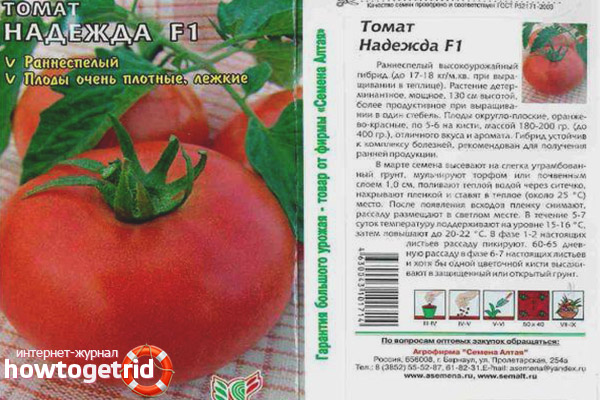The content of the article
Early ripe hybrid tomato Nadezhda F1 is suitable for growing in heated greenhouses, greenhouses without heating, on an open land plot. The plant is determinant, growth stops at the beginning of fruiting.
The bush is distinguished by a large number of stems and leaves that require additional removal, starting from the lower shoots and thinning throughout the bush. This procedure will redirect plant juices to inflorescences, increasing the number and size of fruits, and the speed of ripening.
Ripe tomatoes weigh 80 - 85 grams, which allows you to make laying in glass jars for canning whole. The sweetish taste of tomato and beautiful uniform coloring attracts the attention of buyers, and the elastic flesh with a smooth skin of a rounded fruit allows you to transport it without any problems at any distance.
Features of growing in heated greenhouses
- Seeds are prepared for sowing, depending on where the tomatoes will be grown. For heated film structures and obtaining an early harvest, the beginning of work can be done in late January - early February. The main condition is to maintain stable temperatures and a sufficient amount of light for full growth. Daily fluctuations should not exceed 5 - 7 degrees. And the maximum artificial lighting can be around the clock, until the sun.
- Treated with a manganese solution, the seeds are laid for germination in wooden crates filled with earth mixed with sawdust that retain moisture well. Contain containers for sowing in a dark place for several days, covering the surface with film or newspapers that periodically moisturize as they dry. The temperature should be about 25 degrees Celsius. After the appearance of the first hatching seeds, it is necessary to add lighting by removing the coating from the paper. The sown area can be dusted with a thin layer of earth of 5 mm, to avoid drying of the seed material with a large number of sawdust.
- With the emergence of friendly seedlings, it is recommended to lower the air temperature by several degrees so that the legs of the plants do not stretch and do not become thinner. If seeding was done in cassettes, then there is no need to dive. When 3-4 leaves appear on the stem, the transplant process is quite acceptable if the place is warm enough. The heat of the soil in heated greenhouses is measured with a thermometer lying directly on the ground. At low rates, tomato growth slows significantly.
- From the time of sowing to dive seedlings takes 20 to 25 days and falls in mid-February - early March. Seedlings are completely ready for planting in a permanent place after another 14 to 20 days.
- Growing tomatoes, in the absence of frost, translate into partial warming by the natural rays of the April sun, heating the greenhouse only at night. With a growth of 25-30 cm, they already begin to tie the shoots to supports or racks. The formation of the bush is performed as the side shoots are thrown out and the trunk is overly covered with leaves. In the presence of prolonged cloudy weather, additional lighting is switched on and fertilizers are fertilized to accelerate growth and strengthen the root system.
Getting an early harvest requires additional attention and hassle. Observation of night temperature differences implies additional control and measurement of thermometer readings. But the effort will pay off with beautiful bright ripe tomatoes in May.
Sowing dates for open ground
Seeds are planted in March - April to get the first fruits in June - July. The ripening of the first crop from the moment of the first seedlings is only 90 - 95 days. With a bush height of 60 - 75 cm, it is allowed to experiment in planting planting material in deep furrows of the earth without tying. The bush is perfectly displayed on the tops of the ditch, and excess moisture flowing down does not harm the color of the tomato when ripening under the sun. Watering is standard, with moisture retention at the bottom of the furrow, which allows you to maintain the viability of the bushes at elevated temperatures in the summer.
In open areas with hot dry weather in the summer, there is no urgent need to remove lateral shoots. Tomato directs all forces to maximum flowering and fruiting. The crop variety produces about 8 - 10 kg per square meter. m - subject to landing in rows. The distance between plants is about 30 cm, and between the furrows 60 - 70 cm with manual tillage, and 80 cm with mechanized soil.
If it is possible to grow in several ways at the same time, and the availability of free time for the grower, it turns out to collect a decent crop. The beautiful appearance of the tomato and its running size make it possible to use the variety for sale, canning, personal use, and harvesting for winter time. Unpretentious in care, the variety Nadezhda is interesting both to lovers of cultivation of land in summer cottages, and to professional vegetable growers.
Video: Tomato Care - The First Important Steps










Submit